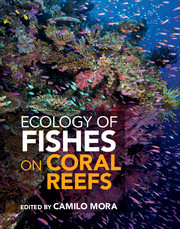Book contents
- Frontmatter
- Contents
- Preface
- Foreword
- List of contributors
- PART I BASIC ECOLOGY
- PART II PATTERNS AND PROCESSES
- PART III HUMAN FINGERPRINTS
- PART IV CONSERVATION
- PART V DEBATES AND PARADIGM SHIFTS
- 23 Is dispersal of larval reef fishes passive?
- 24 Density dependence and independence and the population dynamics of coral reef fishes
- 25 Equilibrial versus non-equilibrial dynamics in coral reef fishes
- 26 Cryptic density dependence: integrating supply-side ecology with population regulation
- 27 Priority effects
- 28 Inverted trophic pyramids
- 29 Shifting baselines in coral reef fishes
- 30 Pluralism explains diversity in the Coral Triangle
- 31 Reef fish biogeographical regions
- 32 Size and sex change
- 33 Quantifying reef fishes: bias in observational approaches
- 34 Seascape ecology of fishes on coral reefs
- 35 The future for coral reef fishes
- 36 Perpetual struggle for conservation in a crowded world and the needed paradigm shift for easing ultimate burdens
- References
- Index
27 - Priority effects
from PART V - DEBATES AND PARADIGM SHIFTS
Published online by Cambridge University Press: 05 May 2015
- Frontmatter
- Contents
- Preface
- Foreword
- List of contributors
- PART I BASIC ECOLOGY
- PART II PATTERNS AND PROCESSES
- PART III HUMAN FINGERPRINTS
- PART IV CONSERVATION
- PART V DEBATES AND PARADIGM SHIFTS
- 23 Is dispersal of larval reef fishes passive?
- 24 Density dependence and independence and the population dynamics of coral reef fishes
- 25 Equilibrial versus non-equilibrial dynamics in coral reef fishes
- 26 Cryptic density dependence: integrating supply-side ecology with population regulation
- 27 Priority effects
- 28 Inverted trophic pyramids
- 29 Shifting baselines in coral reef fishes
- 30 Pluralism explains diversity in the Coral Triangle
- 31 Reef fish biogeographical regions
- 32 Size and sex change
- 33 Quantifying reef fishes: bias in observational approaches
- 34 Seascape ecology of fishes on coral reefs
- 35 The future for coral reef fishes
- 36 Perpetual struggle for conservation in a crowded world and the needed paradigm shift for easing ultimate burdens
- References
- Index
Summary
Priority effects occur when earlier arriving species decrease settlement or survivorship of species arriving later. First identified in reef fishes in the 1980s, 30 years of research have shown that priority effects are produced by predators and competitors, with effects on population abundances and the structure of reef fish assemblages. Territorial and schooling damselfishes, anemonefishes, wrasses, and hawkfish have all been shown to reduce settlement and/or survivorship of other species through defense of shelter and food resources. Species affected are often trophic competitors, but defense of refuges is also an important source of priority effects. Prior presence of predators may strongly reduce recruitment of other species, in some cases producing complete recruitment failure. Priority effects can occur between fishes that settled in an earlier lunar, seasonal, or annual cycle (intercohort) or those that settle in the same cycle (intracohort). Earlier settlement, even by just a few days, may establish an intracohort priority effect and such effects can be transitive between species. Important areas for future research include: sensory cues larvae may use to avoid settling near predators and competitors; the potential role of experience, as well as size, in creating the advantage of earlier settlement; quantifying and modeling the strength of the ecological interactions that produce priority effects; and exploring the spatial and temporal dynamics of priority effects to determine how they contribute to maintenance of reef fish diversity and assemblage structure across the seascape. Understanding priority effects will be an important contribution to predicting responses of reef fish assemblages to ongoing and future changes in composition and structure of coral reef communities.
Priority effects, in which the order of recruitment to a habitat influences community structure, were first described in spacelimited assemblages of sessile marine organisms [534,1489,2443]. Propagules available at the right time and place settle on empty substrate, grow and dominate the space resource, preventing competing species from establishing. Thus communities may differ enormously in composition, structure, function, and successional trajectory, simply depending on order of arrival of settlers.
- Type
- Chapter
- Information
- Ecology of Fishes on Coral Reefs , pp. 242 - 246Publisher: Cambridge University PressPrint publication year: 2015
- 5
- Cited by



